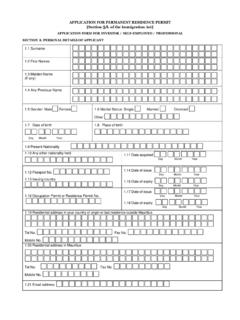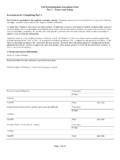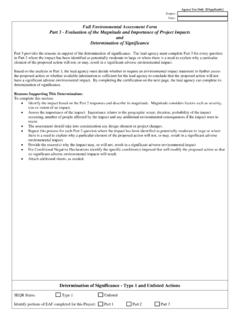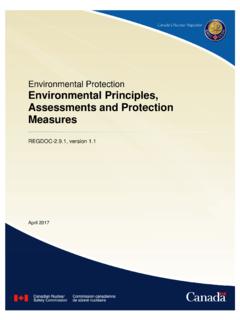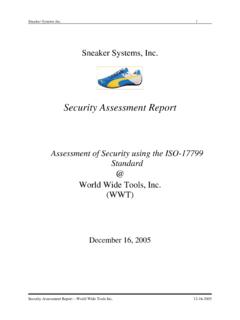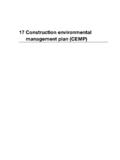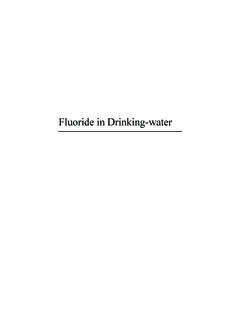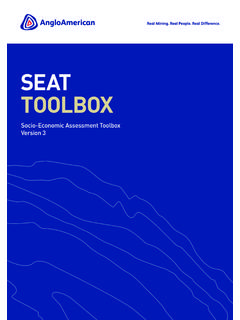Transcription of TO ENVIRONMENTAL IMPACT ASSESSMENT (EIA)
1 A PROPONENT'S GUIDE. TO. ENVIRONMENTAL IMPACT ASSESSMENT . (EIA). Department of Environment Ministry of Environment July 2004. This is not a legal document. It serves as a general guideline. Sectoral guidelines are available at the Department of Environment TABLE OF CONTENTS. Background information ..3. Objective . 3. The Environment IMPACT ASSESSMENT Process ..4. Guideline on the content of an EIA report ..4. Title Page ..4. Non Technical Summary ..5. Introduction ..5. Site and Project Description ..5. Site description ..5. Project description .. 6. Method of ASSESSMENT ..6. Baseline data ..6. Consultations .. 7. Predicted ENVIRONMENTAL IMPACT ..7. Mitigation measures ..7. Residual Impacts ..8. and socio-economic impacts ..8. Monitoring and maintenance ..8. Enhancement opportunities.
2 8..8. Conclusions and summary of ENVIRONMENTAL outcomes .. 8. Supporting Documentation and references ..9. Appendices ..9. Processing of EIA ..9. Appeal ..11. Appendix 1 .12. Appendix 2 ..16. Appendix 3 .. 18. 2. BACKGROUND INFORMATION. What is an Environment IMPACT ASSESSMENT (EIA)? EIA is a study that predicts the ENVIRONMENTAL consequences of a proposed development. It evaluates the expected effects on the natural environment, human health and on property. The study requires a multi-disciplinary approach. The EIA compares various alternatives by which the project could be realized and seeks to identify the one which represents the best combination of economic and ENVIRONMENTAL costs and benefits. Alternatives include location as well as methods, process technology and construction methods.
3 Why do we need an EIA? EIA is one of the most important tools for sound decision making and for achieving sustainable development. Mauritius first adopted formal procedures for EIA in June 1993 following the amendment of the Environment Protection Act (EPA) 1991. In order to further consolidate and reinforce the institutional and legal framework for the protection of the ENVIRONMENTAL assets of Mauritius and a sustainable development, a new Environment Protection Act is in force as from 5 September 2002. The EPA 2002 provides for ENVIRONMENTAL stewardship, greater transparency and public participation in the EIA mechanism as well as a streamlining of the EIA procedures. The EPA 2002 also specifies the contents of the EIA. The requirement for an EIA according to EPA 2002 is at Appendix 1.
4 Which activities are subject to EIA? Undertakings requiring an EIA licence are listed in Part B of the First Schedule of the EPA 2002. (Appendix 2). The EPA 2002 also empowers the Minister to request an EIA for any non- listed activity, which, by reason of its nature, scope, scale and sensitive location could have an IMPACT on the environment. The processing of an EIA application involves consultation with several Ministries/ Authorities and the report is also sent for public comments to the Local Authorities. Thus, a proponent applying for an EIA Licence shall submit in electronic form, and in 18 printed copies of his EIA report to the Department of Environment and also indicate the tentative date of commencement of work. Guideline for the electronic version of an EIA report is at Appendix 3.
5 OBJECTIVE. The objective of this guide is to supplement and elaborate on the contents of an EIA report as spelt out in EPA 2002, as well as provide a general insight in what is an EIA. 3. THE ENVIRONMENT IMPACT ASSESSMENT PROCESS. The EIA process involves the following steps: Screening: it is an important process that assists in deciding whether the project requires an EIA or not. Scoping: the aim of scoping is to ensure that the study addresses all the issues important for decision making. It involves setting terms of reference for the EIA, selecting consultant and review of existing legislation. The EIA study including the following: - Collection of baseline data and information - Public involvement/participation - Identification of impacts in terms of magnitude and significance - Socio- economic analysis of project effects/ IMPACT - Mitigating measures for each IMPACT identified - Analysis of alternatives of the project - Development of a monitoring programme and environment management plan The above study should be documented in the form of an EIA report and submitted at the time of application.
6 GUIDELINE ON THE CONTENT OF AN EIA REPORT. The proponent/consultant preparing an EIA report shall ensure that all socio-economical and ENVIRONMENTAL parameters are addressed and their impacts are identified and taken into account in the project design. The EIA report shall provide substantive and indicative information on the proposed measures to mitigate all adverse ENVIRONMENTAL effects as well as the opportunities for ENVIRONMENTAL enhancement to enable a proper ASSESSMENT . Prior to embarking on a project, a proponent shall ensure that the proposed development is compatible with the zoning of the site and that relevant clearances such as zoning certificate, land conversion permit or lease agreement (if applicable) have been obtained. In case of inappropriate zoning and the absence of proof of land ownership or authorisation, the EIA application will not be considered.
7 No permit for development shall be granted in respect of an undertaking unless there is in relation to it an approval of preliminary environment report or an EIA. licence. An EIA report shall be duly signed and dated by the proponent of the undertaking and all principal consultants involved in the preparation of the EIA report. An EIA report shall be prepared in the format as proposed below: TITLE PAGE. 4. This should contain details of: - the full title under which the EIA has been prepared - the team responsible for the EIA or name of the consultancy if applicable - the proponent - date NON-TECHNICAL SUMMARY. - This should be concise. - The language should be simple and non-technical. - It should give an outline of both the project and location. - It should focus primarily upon key impacts identified in the EIA and measures taken to avoid and reduce them.
8 INTRODUCTION. This should provide background information on the project, the promoters, any experience in similar projects, project costs, benefits, employment opportunities, benefit to local communities, associated problems etc. SITE AND PROJECT DESCRIPTION. This should describe the project and indicate the justification and rationale underlying the project, including: Site Description A description should be given in general terms to indicate the nature and broad character of the local environment. - Ownership of land and proof thereof, or lease agreement clearly indicating the owner's consent is agreeable to the project - Present Zoning of site as per approved Outline Scheme(obtainable from the Town &. Country Planning Board or the local authorities). - Plans and policies with which the project conforms - Site characteristics in terms of site location, landform; present and past land use (if known), accessibility to site, flora and fauna, etc.
9 - Certified and comprehensive site and location plans drawn to scale and duly certified by a Sworn Land Surveyor with known landmarks as reference points and showing waterbodies, wetlands, boreholes,acquifer, stone crushing plants etc within a 1000m radius 5. - Surrounding environment indicating adjacent residential areas/built-up environment, environmentally sensitive areas, watercourses, designated sites of interest. - Other attributes of the area amenities, recreational and agricultural values. - Indication of other similar projects in the surroundings Existing infrastructure and availability of public utilities Project Description - Project initiator - Type of project and associated activities to be carried out. - Need and justification of project. - The design, size and scale of the project.
10 - Detailed site/layout plan drawn to scale of 1:500 indicating site boundaries (as per title deeds) and showing all structures proposed to be put up on site with setbacks from boundaries. - Detailed plans including elevations, plot coverage and gross Floor Area. - Description of project in terms of raw materials, processes, mass balance, equipment, work force, products, type and amount of wastes/effluent produced and its disposal etc. - Training requirements of the project. - The technical, economic and ENVIRONMENTAL features essential to the project. - Diagrams, sketches or landscape architect's impression of the project in the receiving environment. - Proposed schedule for implementation. METHOD OF ASSESSMENT . This should contain details of the EIA procedure including: Baseline Data - Data collection methodology ( survey, matrix or checklist),source of information - What information the EIA was based upon?
